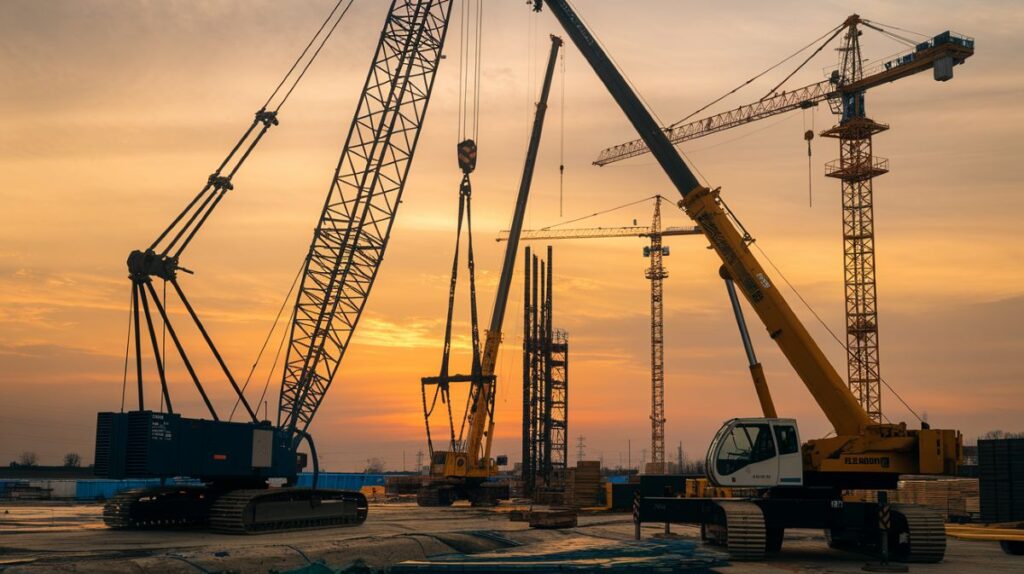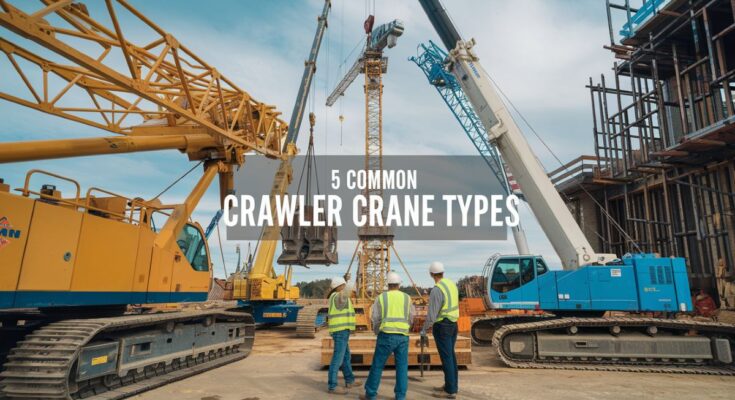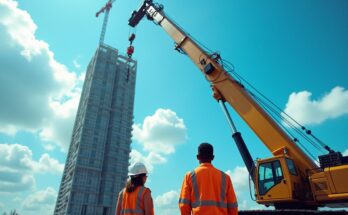Have you ever stood in awe of a massive construction project, wondering how those enormous structures come to life? 🏗️ The secret lies in the powerful machines that dominate construction sites – and among them, crawler cranes reign supreme. These engineering marvels are the unsung heroes of the construction world, lifting and moving colossal loads with precision and ease.
But did you know that not all crawler cranes are created equal? In fact, there are several distinct types, each designed for specific tasks and environments. Whether you’re a construction professional looking to expand your knowledge or simply curious about these mechanical giants, understanding the different crawler crane types can be both fascinating and practical. In this post, we’ll explore the 5 common crawler crane types that are shaping skylines and transforming landscapes across the globe. From the classic lattice boom to the versatile telescopic models, get ready to discover the unique features and applications that make each type indispensable in modern construction.
Lattice Boom Crawler Cranes
Versatility in heavy lifting
Lattice boom crawler cranes are renowned for their exceptional versatility in heavy lifting operations. These powerful machines can handle a wide range of loads, making them indispensable in various industries. Their unique design allows for:
- Adaptability to different job site conditions
- Ability to lift and move diverse types of materials
- Flexibility in boom configuration for various lifting tasks
Ideal for construction and infrastructure projects
Construction and infrastructure projects benefit greatly from lattice boom crawler cranes due to their:
- Stability on uneven terrain
- Capacity to handle heavy structural components
- Ability to operate in confined spaces
| Project Type | Advantages of Lattice Boom Crawler Cranes |
|---|---|
| Bridges | Long reach for spanning water bodies |
| Skyscrapers | High lifting capacity for steel beams |
| Factories | Precision placement of heavy machinery |
Long reach capabilities
One of the most significant advantages of lattice boom crawler cranes is their impressive reach:
- Extendable boom sections for increased height and radius
- Ability to access hard-to-reach areas on job sites
- Ideal for projects requiring lifts at significant distances
Easy transportation and assembly
Despite their size, lattice boom crawler cranes are designed for efficient transportation and assembly:
- Modular components for easy disassembly
- Compact storage and transport configurations
- On-site assembly with minimal additional equipment
These features make lattice boom crawler cranes a popular choice among contractors who need a powerful, versatile lifting solution that can be readily deployed across different project sites.
Telescopic Boom Crawler Cranes
Compact design for tight spaces
Telescopic boom crawler cranes are renowned for their versatility in confined areas. These cranes feature a telescoping boom that can be extended or retracted, allowing them to navigate through tight spaces with ease. Their compact design makes them ideal for urban construction sites, industrial facilities, and other areas where space is at a premium.
| Feature | Benefit |
|---|---|
| Retractable boom | Easily maneuverable in tight spaces |
| Compact base | Smaller footprint on job sites |
| Adjustable outriggers | Stability in various terrains |
Quick setup and deployment
One of the key advantages of telescopic boom crawler cranes is their rapid setup time. Unlike lattice boom cranes that require assembly, these cranes can be operational within minutes of arriving on site. This quick deployment capability offers several benefits:
- Reduced downtime between lifts
- Increased productivity on time-sensitive projects
- Lower labor costs associated with crane setup
Smooth operation and precise control
Telescopic boom crawler cranes are equipped with advanced hydraulic systems that provide operators with exceptional control over load movements. This precision is crucial for:
- Placing loads in exact positions
- Working around obstacles safely
- Minimizing the risk of accidents or damage to materials
The smooth operation of these cranes also contributes to improved safety on job sites, as it reduces the likelihood of sudden movements that could destabilize loads. With their combination of compact design, quick setup, and precise control, telescopic boom crawler cranes are a valuable asset for a wide range of construction and industrial applications.
Hydraulic Crawler Cranes
Enhanced lifting capacity
Hydraulic crawler cranes have revolutionized the construction industry with their impressive lifting capabilities. These machines utilize advanced hydraulic systems to provide superior power and precision, allowing them to handle heavier loads than traditional mechanical cranes.
| Feature | Benefit |
|---|---|
| High-pressure hydraulics | Increased lifting capacity |
| Precise control | Improved load handling |
| Adjustable boom configurations | Versatility in various job sites |
Improved safety features
Safety is paramount in crane operations, and hydraulic crawler cranes excel in this area. They come equipped with state-of-the-art safety features that significantly reduce the risk of accidents and enhance overall job site security.
- Load moment indicators
- Anti-two block systems
- Outrigger monitoring systems
- Operator cab protection
Reduced maintenance requirements
One of the key advantages of hydraulic crawler cranes is their lower maintenance needs compared to mechanical alternatives. This translates to reduced downtime and increased productivity on construction projects.
Environmentally friendly options
As the construction industry moves towards more sustainable practices, hydraulic crawler cranes are leading the way with eco-friendly innovations:
- Electric-powered models
- Hybrid systems combining diesel and electric power
- Regenerative systems that capture and reuse energy
These environmentally conscious options not only reduce emissions but also offer quieter operation, making them ideal for urban construction sites. With their combination of power, safety, and sustainability, hydraulic crawler cranes are an excellent choice for modern construction projects.
Rough Terrain Crawler Cranes
All-terrain mobility
Rough Terrain Crawler Cranes are designed to excel in challenging environments, offering unparalleled mobility across various terrains. These versatile machines combine the best features of crawler cranes and rough terrain cranes, making them ideal for construction sites with difficult access.
- Key features of all-terrain mobility:
- Large, rugged tires
- Powerful engines
- Advanced suspension systems
- Four-wheel drive capability
Stability on uneven surfaces
One of the most significant advantages of Rough Terrain Crawler Cranes is their ability to maintain stability on uneven surfaces. This feature is crucial for ensuring safe and efficient operations in diverse construction environments.
| Surface Type | Stability Features |
|---|---|
| Soft soil | Wide crawler tracks |
| Slopes | Adjustable outriggers |
| Rocky terrain | Enhanced counterweight systems |
Dual-purpose functionality
Rough Terrain Crawler Cranes offer dual-purpose functionality, combining the benefits of both crawler and mobile cranes. This unique characteristic allows them to perform a wide range of tasks efficiently.
- Advantages of dual-purpose functionality:
- Reduced equipment needs on-site
- Increased project flexibility
- Cost-effective solution for varied lifting requirements
With their ability to navigate challenging terrains, maintain stability on uneven surfaces, and offer dual-purpose functionality, Rough Terrain Crawler Cranes have become an essential tool in modern construction projects. Their versatility makes them particularly valuable in remote locations or areas with limited infrastructure.
Tower Crawler Cranes
Vertical lifting capabilities
Tower crawler cranes offer exceptional vertical lifting capabilities, making them indispensable for high-rise construction projects. These cranes can effortlessly hoist heavy loads to impressive heights, often reaching well beyond 100 meters. Their unique design allows for precise control and stability even when lifting at extreme altitudes.
Space-saving design for urban projects
In densely populated urban areas, space is at a premium. Tower crawler cranes excel in these environments due to their compact footprint:
- Minimal ground space required
- Ability to work in tight spaces
- Reduced impact on surrounding infrastructure
This space-saving design makes them ideal for city-center construction projects where traditional cranes might struggle to operate effectively.
Increased lifting height and radius
Tower crawler cranes offer a significant advantage in terms of lifting height and radius compared to other crawler crane types:
| Feature | Tower Crawler Crane | Standard Crawler Crane |
|---|---|---|
| Max Height | 100+ meters | 30-60 meters |
| Working Radius | Up to 80 meters | 20-40 meters |
| Load Capacity | High at extended reach | Decreases with reach |
Adaptability to various construction phases
One of the key strengths of tower crawler cranes is their versatility throughout different stages of construction:
- Initial site preparation
- Foundation work
- Structural framework assembly
- Exterior cladding installation
- Interior fit-out operations
This adaptability makes tower crawler cranes a cost-effective choice for large-scale projects, as they can remain on-site from start to finish, reducing the need for multiple crane types or frequent equipment changes.

Crawler cranes play a vital role in construction and heavy lifting operations, with each type offering unique advantages. From the versatile lattice boom cranes to the compact telescopic models, the powerful hydraulic variants, the adaptable rough terrain cranes, and the towering crawler cranes, there’s a solution for every job site challenge.
Understanding these five common crawler crane types empowers project managers and construction professionals to make informed decisions when selecting equipment. By choosing the right crane for the task at hand, you can enhance efficiency, safety, and productivity on your construction sites. Consider the specific requirements of your project and consult with crane experts to determine which type best suits your needs.




